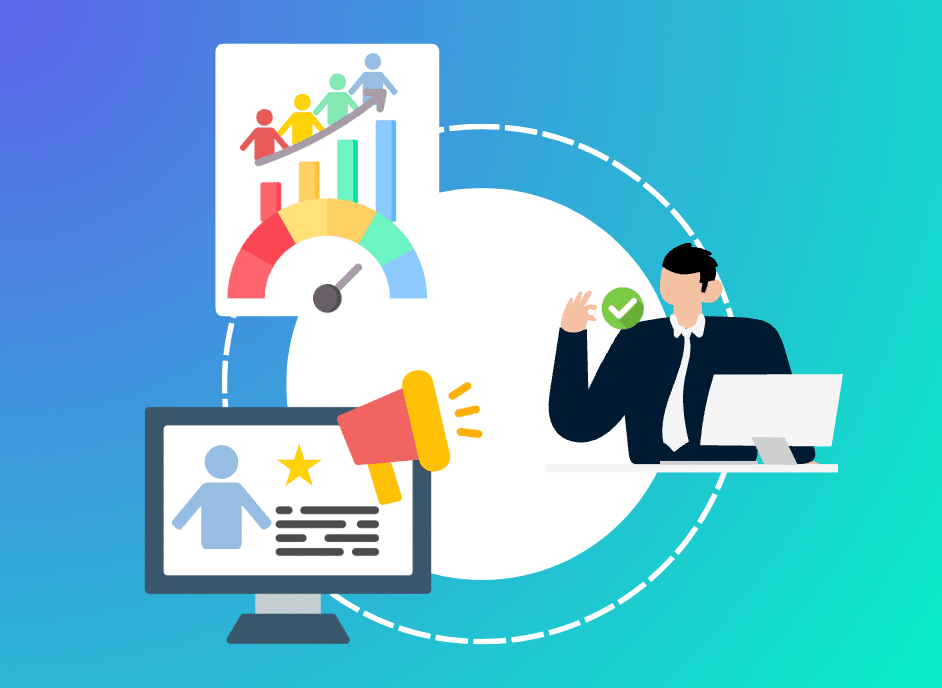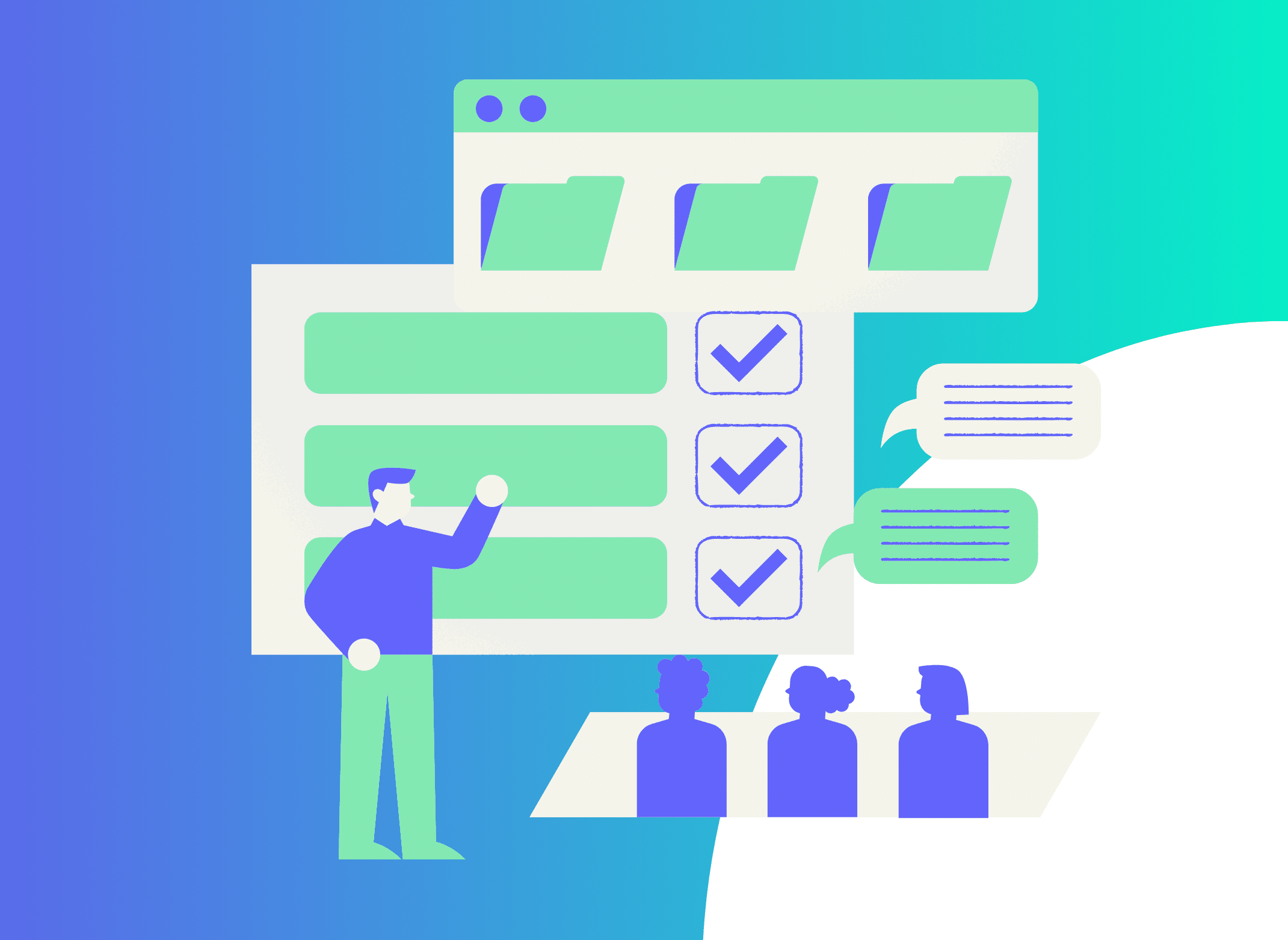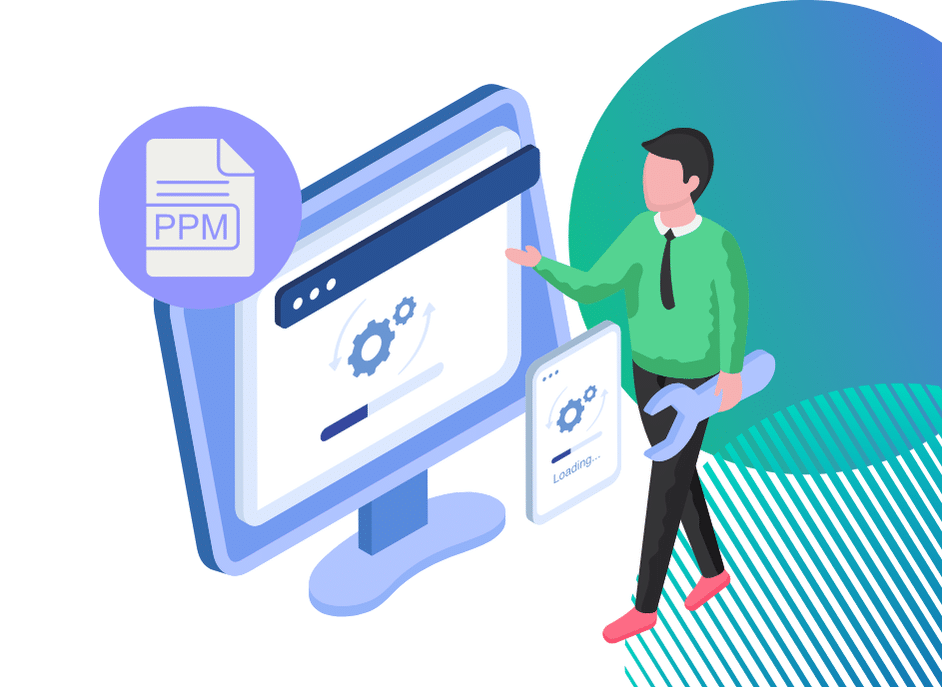Skills Matrix: What is it Used For?

A strategic tool for both a project and a company as a whole, the skills matrix helps you boost the performance of your teams.
Anticipating training needs, aligning skills with strategic objectives or identifying your leaders of tomorrow, this skills mapping is a real performance lever.
So in concrete terms, what is a skills matrix and what are its advantages? In this article, we help you understand precisely what a skills matrix is for and how to set it up.
What is a Skills Matrix?
Skills matrix: Definition
🔎 Synonym: skills mapping, skills grid.
The skills matrix is a visual representation of the skills of a company or project. Often represented in the form of a table or a grid, it presents an overview of the skills available but also necessary to carry out the missions entrusted by clients.
What Are the Challenges of a Skills Matrix?
A true strategic planning tool, it presents:
- the necessary expertise,
- the current level of performance of employees,
- the requirements to be met.
The competency matrix assesses both technical and behavioural competencies . It ensures that these are aligned with the company's strategic objectives and needs. Constantly evolving, this tool is essential for effective skills management.
Questions:
The competency framework defines which competencies are needed, while the competency matrix shows who has which competencies and at what level.
The Benefits of a Skills Matrix in Project Management
Better Visibility on Available Skills
The skills matrix offers a clear view of all the skills available in the company. This then meets three objectives.
- Highlight strengths and weaknesses: Skills mapping highlights the skills available and those that need to be invested in. In addition, it makes it possible to identify expert profiles within the company who can act as trainers.
- Evaluate the level of performance of employees: this evaluation is essential in order to identify the available capacities. It makes it possible to reveal possible versatility and potential for higher-level positions. Skills assessment is essential to the implementation of a relevant training plan.
- Secure the company's skills : by identifying precisely who masters what, the skills matrix makes it possible to identify critical points of dependence. A rare skill, held by a single person, can be considered as such. Thus, it is essential to limit this type of situation but also to anticipate solutions.
Eased Recruitment
- Clarify expectations for each position
The skills matrix helps facilitate recruitment as it maps the company's jobs while clarifying the needs for each position.
Thus, it helps to streamline the recruitment process because it facilitates the selection of candidates, which is then based on objective criteria.
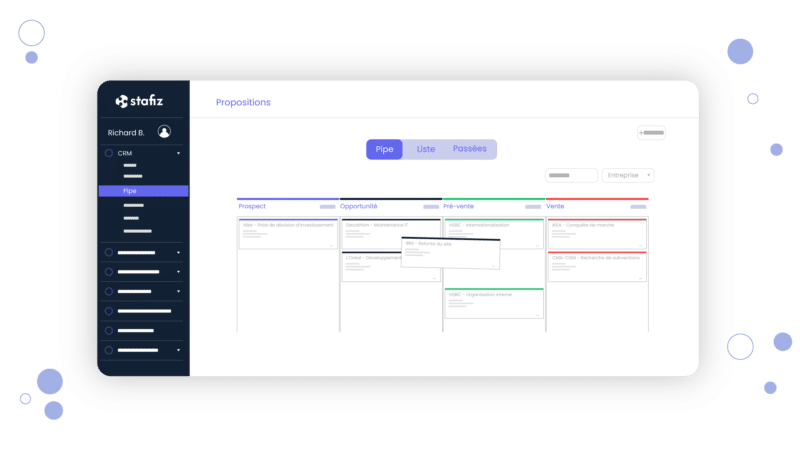
You too, speed up your recruitment processes!
- Identify skills gaps and shortages
The skills matrix reveals skills gaps and shortages, allowing for better anticipation of recruitment needs. Rigorous and anticipatory resource planning, both at the project level and at the company level as a whole, is therefore essential.
Optimized Talent Management
By identifying key competencies, the competency matrix facilitates talent management. The visibility it offers facilitates the comparison between actual skills and those required, thus highlighting training needs.
- Setting up adapted training plans
Once the missing skills have been identified, it is necessary to put in place strategic skills development plans. This can take the form of training or mentoring, which will allow employees to develop their skills. The idea is also to propose training plans in line with the company's strategic objectives.
In addition, well-designed training plans make it possible to limit dependencies in the event of the departure of key elements, thus constituting an effective backup strategy.
- Allocate resources as needed
The competency matrix is relevant for resource management as it provides insight into potential gaps and future needs. This makes it easier to allocate resources through increased visibility into skills and resource availability.
In addition, a clear view of the company's skills offers reliable and actionable data, useful to the PMO directly and to the PMOs responsible for managing resources.
Improved Performance and Service Quality
The skills matrix is a strategic lever for the company. Indeed, it improves the organization of work. For example, it limits delays due to a lack of skills and increases the quality of deliverables through more strategic choices in terms of resources.
Contribute to the Employees' Professional Development
Skills mapping also brings many benefits for employees. It contributes to their professional development in three ways.
- It provides an objective structure for assessing competencies by defining specific assessment criteria, this structure is clear and allows for uniform assessment and ensures objectivity.
- It facilitates the comparison of employee levels , which is then evaluated on an objective basis, allowing for a more transparent and accessible awarding of promotions.
- Finally, it helps to reveal potential. By comparing actual and expected skills, gaps can be observed in both directions, so that employees with more skills than those required for their position could be offered a position that is more in line with their skills. Thus, the skills matrix can help identify the leaders of tomorrow.
What are the Different Types of Skills Mapping?
The Individual Skills Chart
The individual competency table serves several functions:
- evaluate the different profiles to organize and optimize resources on projects,
- compare current skills with those required,
- build development plans and identify training needs.
Example of an individual skills table
An Excel table with the names of the employees on the rows and the expected skills in columns. Each cell then contains the level, the scale of which must be determined beforehand.
Need a more visual representation? The radar chart (or kiviat diagram) may also be suitable for you. Indeed, its curves draw attention to the gaps to be bridged between the actual and expected level.
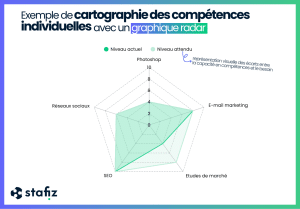
Skills Mapping by Team or Project
The team or project skills matrix is used to assess the available skills of a team. It highlights strengths and areas for optimization.
This matrix is essential at the beginning of the project to ensure that the team has all the necessary skills to carry out the project.
Example of skills mapping by team or project
This can also take the form of a table, this time listing the expected missions and the available expertise.
Job and Skills Matrix
This type of job and skills mapping lists the skills expected for a specific position.
Once established, it allows the comparison between the expectations and the actual skills of employees. Thus, it can help improve internal mobility, recruitment or training needs.
Example of a competency matrix by position
Still in the form of a table, the skills matrix lists, by position, the expected skills, both technical and behavioral.
The Evolution Skills Matrix
The Evolution Skills Matrix shows the stages of progression based on the level of seniority. This scale can be graduated using terms or numbers, providing an accurate framework for evaluating objectively.
Example of an evolution skills matrix
- Level 1 or Initial: less than 6 months of experience, performs simple tasks under supervision.
- Level 2 or Autonomous: 6 months to 2 years, partial autonomy, taking initiatives on known subjects.
- Level 3 or Referent: 2 to 5 years, autonomous management, ability to supervise a small team.
- Level 4 or Leader: strong leadership, management of complex projects, mentoring role.
- Level 5 or Strategic: strategic vision, innovation, management of large-scale projects, transmission of knowledge.
The Versatility Matrix
In reality, this tool differs from the skills matrix, but the two are complementary. The versatility matrix evaluates each employee's ability to perform different tasks. Thus, it measures the flexibility of employees and makes it possible to identify those who are able to perform interchangeable positions. The Versatility Matrix is part of a capacity management and succession planning approach. We also talk about multi-skills.
Example of a versatility matrix
A table with the employee's name, the skills expected for his position, and the expertise he or she has.
How To Create an Effective Skills Matrix and Update It?
The skills mapping process is only really useful when it is regularly updated and updated. It is therefore necessary to integrate its use into your processes to avoid making mistakes related to its obsolescence.
Develop an Adopting Strategy
Adopting a skills matrix to your resource management will take more or less time to implement depending on the size of your company. A new company will be more comfortable working on it than a more substantial and mature company.
This makes it all the more important to involve stakeholders from the creation of the matrix. In this way, employees will understand the challenges and interests, especially regarding their own professional development.
To facilitate collaboration with the managers of each department, it is therefore necessary to create a regular process.
The Stafiz team recommends the following adoption process to ensure that updates are regular.
The update exercise can be easily swept away from priorities and schedules. Don't hold it against your teams, who tend to focus their efforts on customer missions.
To ensure that everyone plays the game, don't hesitate to plan and book dedicated slots to update your skills matrix. And the good news is that they can integrate with your existing managerial processes!
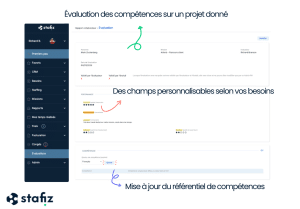
In Stafiz, you can integrate the skills acquired during the period or the mission into your monthly or end-of-project evaluation sheets. Then assign a deadline to each team leader, who will in turn organize these staff interviews.
This process is effective because it makes it possible to take stock at specific periods: past and current work is then freshly kept in memory for more objective evaluations.
In addition, the database automatically updates the CV of each employee. As a result, the skills worked on and/or acquired are then taken into account in your allocation of resources, as soon as the evaluation is validated.
To make this exercise a recurring activity, all you have to do is :
- create notification reminders directly in Stafiz,
- or opt for an invitation in the calendar app of your choice.
This method invites collaboration by mobilizing and empowering teams. For managers, capacity monitoring is made easier, and data more reliable.
Be careful, it will also be necessary to change the needs of the matrix! As the market is constantly evolving, you must regularly monitor the new skills and technologies required to continue to meet customer needs.
Define a Usage Strategy
To fully reap the benefits of the Skills Matrix, it's important to understand why, and for what purpose, you're using it.
There are three main objectives related to the use of a competency matrix:
- the assessment of the level of competences,
- identification of resource needs,
- facilitate and optimize the allocation of resources.
- Assess the level
Mentioned above, it first makes it possible to situate the level of an employee's skills in comparison to the expected level.
It then makes it possible to monitor the evolution and development of skills over the long term, but also to integrate new objectives.
- Identify a skills gap
With an overview of the skills needed within the company, it becomes easier to spot gaps or gaps. This strategy aims to plan for the long term, and thus minimize the risks associated with resource planning.
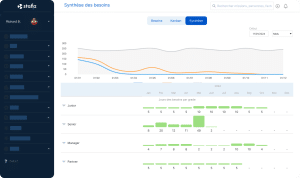
Anticipation of profile needs by seniority level in Stafiz.
This representation helps to make the right decisions to fill the gaps identified, either through recruitment or training.
It is also a good analytical tool. Maybe the capacity itself is sufficient, but its use is not optimal.
- Maximize resource allocation
In the event that your resource planning Indeed, it lacks efficiency, so the Matrix skill is a good way to better organize the load.
By choosing Stafiz for your resource planning, you benefit from a dynamic integration of your skills map into your work environment. As a result, all changes updated in an employee's CV are taken into account in project planning.
Thus, schedule data, availability but also KPIs such as the utilization rate are automatically recalculated.
The allocation of resources is then facilitated. There is no need to refer to an external document to look for the right people to position or replace.
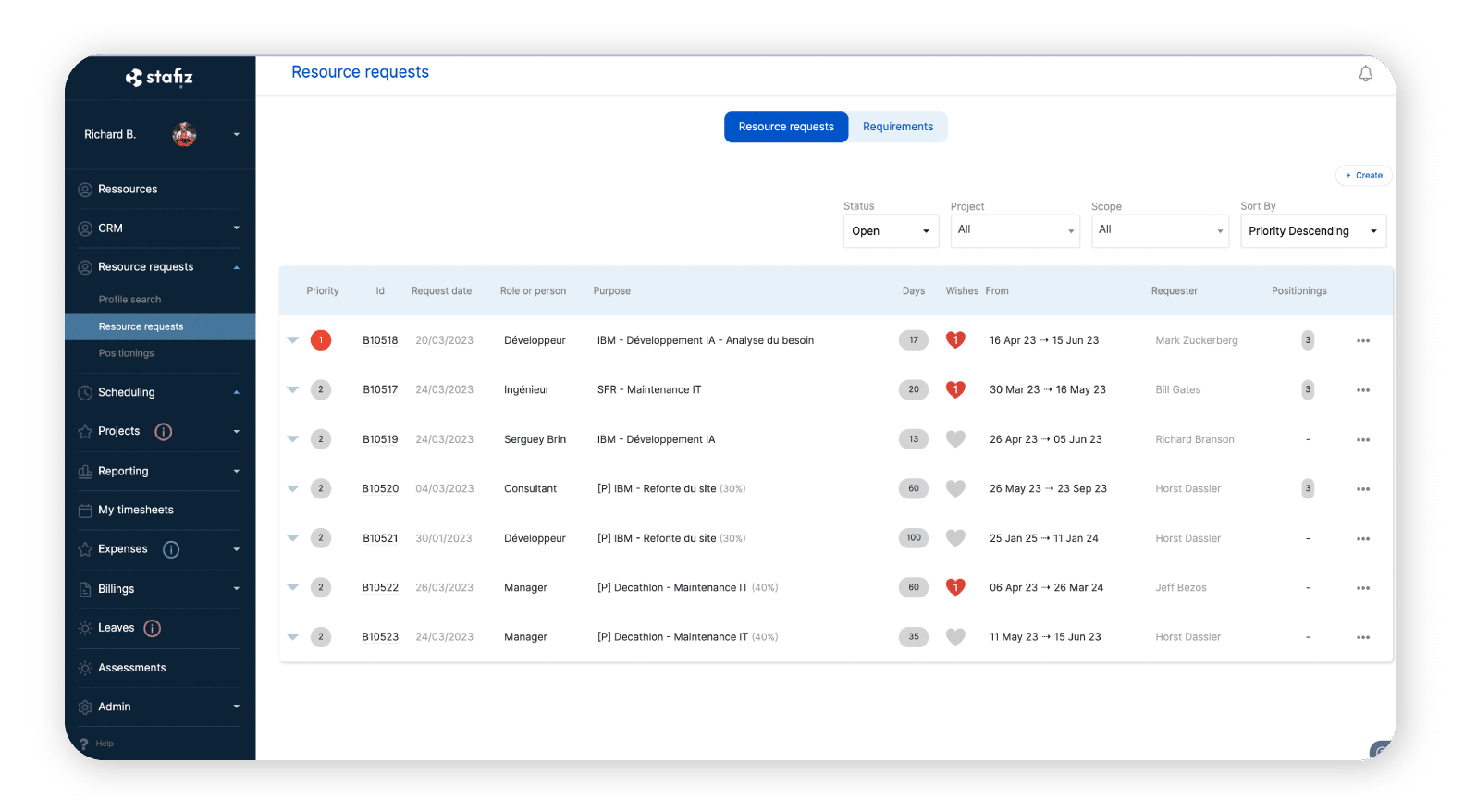
Stafiz goes further!
Create your projects, and let our algorithm suggest the best profiles to assign according to their skills and level, while taking into account their availability.
How To Make a Skills Matrix?
Once you've identified the right strategy, all you have to do is get started with the creation stage!
You can choose to contact us and find out how to set up your skills management with Stafiz, or choose to download one of our skills matrix templates.
- Step 1: Identify essential skills.
Draw up a complete inventory of the skills necessary for your activity using several approaches:
- by trade,
- by team,
- per employee,
- by hierarchical role,
- by tasks, or types of projects.
Don't hesitate to consult with managers to identify truly strategic skills and set realistic expectations that meet the needs of the field.
- Step 2: Set skill levels.
Defining the different skill levels corresponding to each skill can be related to seniority or the position in question. These are the levels of mastery – from novice to expert – mentioned above. It is important to clearly define the criteria for measuring them to eliminate bias.
However, the competency scale can be punctuated by descriptive criteria in order to take into account skills that are difficult to measure, such as soft skills. For example, we could talk about a curious novice or a seasoned expert, going through intermediate levels.
- Step 3: Identify the skills available.
The time has come to map, but also to evaluate the company's skills.
To do this, the mobilization of managers and employees is requested by various means:
- individual interviews,
- performance interviews,
- skills tests,
- evaluation by the manager,
- or self-assessment.
Favor several methods to obtain a clear and as objective picture as possible by cross-referencing figures and perceptions.
From here, you can then assign a skill level corresponding to each key skill identified in the matrix.
- Step 4: Develop development plans.
Once skills have been mapped and assessed, skills gaps are identified. It is now necessary to adopt strategies to address them, such as:
- training plans,
- a mentoring system,
- specific projects,
- professional development activities.
So many solutions that help you maximize the impact of your investments!
The matrix format highlights talent: high potential, as well as employees in difficulty. It becomes easier for you to prioritize priorities and needs.
Don't skip the skills matrix! It is a simple tool to adopt, and the benefits will have a positive impact on your project management, and consequently, your productivity and profitability.
If you are an agency, a IT Services or a consulting firm, Stafiz will be able to meet your needs thanks to a dynamic integration of your resource planning to your project management.
Questions:
The competency matrix is a great tool, but it still has some limitations.
- A fixed tool: without continuous updating through software such as Stafiz, the matrix becomes obsolete. In the worst case, it misleads strategic decision-making.
- Subjectivity: the level of competence can be assessed in a biased way, especially if the assessment is based solely on self-assessment or if it is poorly calibrated by managers. It is therefore necessary to opt for several methods.
- An administrative burden: time-consuming, it can be difficult to maintain on a large or even very large scale.
- Closed doors: Limiting expectations per position can be arbitrary and limit employees' learning and potential.
To remain useful, the matrix must be constantly updated.
To map the available skills, you can use tools such as notion, Excel or Google sheets for a table format, or Miro for more visual representations.
However, to benefit from smooth project management, we recommend the Stafiz solution to centralize your activity.
- Involve the teams from the beginning: define together the key skills and the expected level.
- Communicate the objective of the approach: it is not a question of control or sanction, but of a desire to optimize the load and an opportunity for development. In addition, the matrix is also useful for employees to find the right contact person on certain topics.
- Include the matrix in project management: especially in project assignment and annual reviews. The more it is used, the less it will be neglected or experienced as a painful administrative burden.
- Promotes feedback: through two-way evaluations and individual and collective axes.
